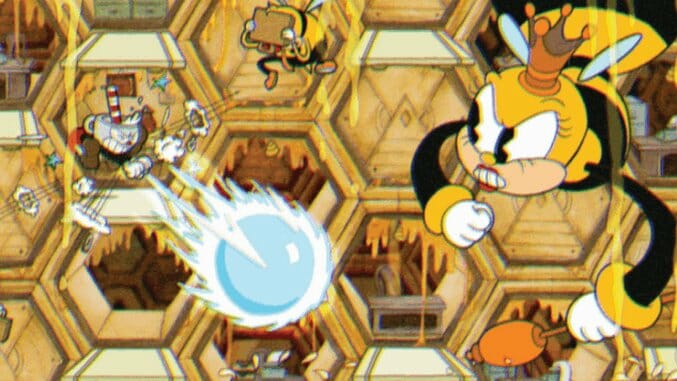
First I have to kill the bee cop. I’m inside a hive inside a vibrating yellow apartment building in a cartoon city that looks like it was hand-drawn by somebody’s great-grandparents, trying to shoot this fat bee enough times to make him buzz off for good. I’m dodging harried bee workers on their morning commute, with papers sticking out of their overstuffed briefcases, and weaving between the candy-colored shrapnel from the cop’s bombs. If I make it past him I come face to face with the queen, who alternates two different kinds of projectiles between waves of bees that fly out like fighter jets. If I land enough shots on her, she then turns into a jet that takes up the entire bottom of the screen, with all of her weapons trained right on me. And this entire time, from the very start, there’s a sea of honey constantly rising up from below, forcing me to jump from platform to platform this entire time to avoid getting hurt. Three hits (sometimes four, depending on what power-ups I have equipped) and I’m dead.
Scenarios like this are why Cuphead has quickly developed a reputation as a brutally hard videogame. I played this same battle for almost an hour before winning it, immediately jumping back in as soon as I died every time until I finally took that queen bee down. It sounds frustrating. It should be frustrating. And I’ll admit to yelling out after a few failed attempts and maybe slamming the controller onto the couch once or twice. Despite those momentary setbacks, though, I never really felt all that angry while playing the game. The opposite actually happened: Cuphead is one of the most soothing and relaxing games I’ve played this year.
Part of that can be attributed to the game’s gorgeous aesthetic. Its Fleischer Brothers-aping art style and jazz score evoke the late ‘20s and early ‘30s, a period that in reality saw great cultural upheaval and moral recalculation, but long ago faded into the warm glow of “simpler times” nostalgia. As Paste’s Holly Green wrote yesterday, there’s something inherently comforting about how Cuphead looks and sounds.
That’s not the whole story here, though. Cuphead’s difficulty might be alienating, its repetition numbing, to many, for completely understandable reasons. It’s the game’s structure that makes it not just tolerable but legitimately relaxing for me, both how the boss battles that make up most of the action play out and how I access them.
The most frustrating thing about replaying a hard game over and over is the sense of lost time. I’ll die at one particular moment or boss and go back to the start of the level, having to repeat minutes over and over before I get another crack at whatever killed me. In extreme cases, in the kind of classic arcade and videogames that Cuphead pays tribute to, and that I grew up playing, games made before passwords, battery saves and save files, I would have to replay an entire game multiple times before I could successfully take out the final boss.
Cuphead smartly leaves that kind of repetition in the past. Its boss battles are direct and succinct: walk up to an icon on a map, press a button, and a brawl is surely brewing. There’s no real punishment to death. I don’t lose all my progress like in a roguelike or have to retread a lot of deadly ground as in Dark Souls. I can jump right back into the fray. This eliminates the sort of time-wasting that can make older games so interminable today, and also lets me focus solely on recognizing the multiple different patterns found in each boss fight. And with that pattern recognition comes another reason why Cuphead’s actually pretty calming.
As hard as these battles are, and as precise as my motions have to be, they all boil down to memory and skill. That’s true of most games, sure, but once I know what to expect from one of Cuphead’s bosses the difficulty almost stops being an issue. I can formulate a plan and success becomes a matter of simply being able to pull it off. The two-dimensional view helps: I can see my enemy and its bullets at all times, eliminating the camera issues and simplifying the timing that makes something like a Dark Souls boss fight so infuriating. When I die in Cuphead I always know why and I always know what I have to do to avoid it the next time; the challenge is simply getting the timing down, and when it comes to that this game isn’t nearly as difficult as many of the other notoriously hard games that it’s compared to.
Cuphead asks a lot of the player. It’s earned its reputation. But by prioritizing repetition while somehow avoiding all fat and extra padding, and by wrapping all of this in what might be the most beautiful and playful presentation in games history, it’s also a supremely relaxing game for me. And in this world that we’re living in, anything that can calm me down for even an hour or two is a triumph.
Garrett Martin edits Paste’s games and comedy sections. He’s on Twitter @grmartin.